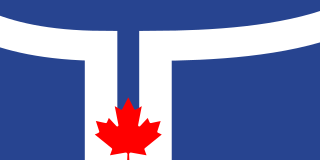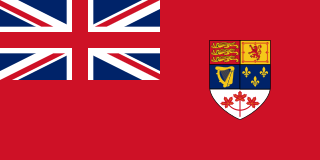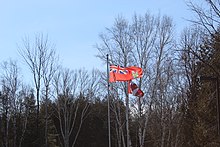
The Union Jack or Union Flag is the de facto national flag of the United Kingdom. The Union Flag was also used as the official flag of several British colonies and dominions before they adopted their own national flags. The flag continues to have official status in Canada, by parliamentary resolution, where it is known as the Royal Union Flag.

The flag of South Africa was designed in March 1994 and adopted on 27 April 1994, during South Africa's 1994 general election, to replace the previous flag used from 1928–1994.

The National Flag of Canada, often simply referred to as the Canadian flag or, unofficially, as the Maple Leaf Flag or l'Unifolié, consists of a red field with a white square at its centre in the ratio of 1∶2∶1, in which is featured a stylized, red, 11-pointed maple leaf charged in the centre. It is the first flag to have been adopted by both houses of Parliament and officially proclaimed by the Canadian monarch as the country's official national flag. The flag has become the predominant and most recognizable national symbol of Canada.

The flag of Newfoundland and Labrador was introduced in 1980 and was designed by Newfoundland artist Christopher Pratt. The flag design was approved by the House of Assembly of the province of Newfoundland, Canada, on May 28, 1980. It was flown for the first time on Discovery Day, June 24, 1980. The name of the province was changed to Newfoundland and Labrador by an amendment to the constitution of Canada in December 2001 at the request of the provincial legislature.

The coat of arms of Canada, also known as the Royal Coat of Arms of Canada or, formally, as the Arms of His Majesty The King in Right of Canada, is the arms of dominion of the Canadian monarch and, thus, also the official coat of arms of Canada. In use since 1921, it is closely modelled after the royal coat of arms of the United Kingdom, with French and distinctive Canadian elements replacing or added to those derived from the British version.

The Red Ensign or "Red Duster" is the civil ensign of the United Kingdom of Great Britain and Northern Ireland. It is one of the British ensigns, and it is used either plain or defaced with either a badge or a charge, mostly in the right half.

In British maritime law and custom, an ensign is the identifying flag flown to designate a British ship, either military or civilian. Such flags display the United Kingdom Union Flag in the canton, with either a red, white or blue field, dependent on whether the vessel is civilian, naval, or in a special category. These are known as the red, white, and blue ensigns respectively.

The maple leaf is the characteristic leaf of the maple tree. It is most widely recognized as the national symbol of Canada.

The flag of New Brunswick consists of a golden lion passant on a red field in the upper third and a gold field defaced with a lymphad on top of blue and white wavy lines in the bottom two-thirds. Adopted in 1965 shortly after the new national flag was inaugurated, it has been the flag of the Canadian province since February 24 of that year. It is a banner of arms modelled after the province's coat of arms.

The coat of arms of Ontario is the armorial emblem representing the Canadian province of Ontario. The arms contain symbols reflecting Ontario's British heritage, along with local symbols. At the upper part of the shield is the red cross of St. George, representing England. The lower portion of the shield features three golden maple leaves on a green background.

The flag of Manitoba consists of a Red Ensign defaced with the shield of the provincial coat of arms. Adopted in 1965 shortly after the new national flag was inaugurated, it has been the flag of the province since May 12 of the following year. Its adoption was intended to maintain the legacy of the Canadian Red Ensign as the country's unofficial flag, after the adoption of the Maple Leaf Flag in 1965. Manitoba's flag has been frequently mistaken for the flag of the neighbouring province of Ontario, which is also a Red Ensign with its respective coat of arms. This, along with criticisms of a lack of inclusivity of the flag, has led some Manitobans to call for a new and more distinct flag.

The flag of Alberta is an official symbol of the province of Alberta, Canada. In 1968, the provincial legislature authorized the design of a flag, adopting it on 1 June 1968.

The coat of arms of Toronto is a heraldic symbol used to represent the city Toronto. Designed by Robert Watt, the Chief Herald of Canada at the time, for the City of Toronto after its amalgamation in 1998. The arms were granted by the Canadian Heraldic Authority on 11 January 1999.

The City of Toronto flag, often simply referred to as the flag of Toronto, is the flag adopted by Toronto City Council to represent the city. The flag was designed by Renato De Santis and includes a white outline of Toronto City Hall on a blue field, and a red maple leaf at the base of the towers.

Regional tartans of Canada are represented by all Canada's provinces and territories having a regional tartan, as do many other regional divisions in Canada. Tartans were first brought to Canada by Scottish settlers; the first province to adopt one officially was Nova Scotia in 1956, and the most recent province was Ontario, in 2000. Except for the tartan of Quebec, all of the provincial and territorial tartans are officially recognized and registered in the books of the Court of the Lord Lyon, King of Arms of Scotland.

The Canadian Red Ensign served as a nautical flag and civil ensign for Canada from 1892 to 1965, and later as the de facto flag of Canada before 1965. The flag is a British Red Ensign, with the Royal Union Flag in the canton, emblazoned with the shield of the coat of arms of Canada.

Richard Heath Rohmer is a Canadian aviator, lawyer, adviser, author and historian.

The Great Canadian flag debate was a national debate that took place in 1963 and 1964 when a new design for the national flag of Canada was chosen.

The flag of the governor general of Canada is a flag used as a symbol to mark the presence of the governor general of Canada. Such a flag has been used by governors general since just after Canadian Confederation and the design has altered over decades. The current flag was adopted in 1981.



























